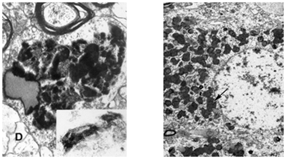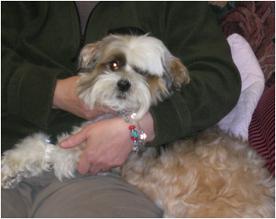


|
ReGena-Vet Laboratories, LLC |
|
The Best Medicine for Our Best Friends |
|
Tomorrow’s Cures Today |


|
Neuronal Ceroid Lipofuscinosis (NCL): RECRUITING PATIENTS Because of our success in correcting genetic deficiencies of cats, we were asked by the Tibetan terrier community if we could test canine MSCs for their ability to treat NCL. NCL is a lysosomal storage disease that causes the deposition of osmophilic (black) granules in neurons. To the right are electron micrographs of cortical samples from an NCL TT brain (right) and a child’s brain that died of NCL (Batten’s disease) (left) (17). Note the similarity of the aberrant storage vesicles. Early signs of NCL in TTs include behavioral changes such as loss of house training, nervousness, anxiety, aggression and motor impairment. There is a gradual loss of vision and the ability of the pupil to normally constrict in daylight. The specific mutation has now been identified in TTs (18) and it had been previously discovered in people (19). A test for this and other genetic diseases is available through the OFA (www.offa.org). With support from the TT Health & Welfare Foundation, we have treated four NCL TT dogs. All four of the dogs have shown demonstrable improvement with no adverse effects related to the injections. The first dog injected was Shania (right). She has had marked improvement in behavior and attitude for the past 10 months. Note the “glowing” eye. In later stages the dogs are blind and in the earlier stages, the pupillary light response (PLR) is |


|
Ongoing Clinical Trials 7 |
|
From Katz, et al (18) |
